New DaRK
5 Questions About: PornographyPoem: Sunrise Over Worcester
5 Questions About: Jason Pinter
12 Signs That You Might Be A Banker
The 9 Worst Movies to Win Oscars
Book Review: Narrow Miss for "Above the Law"
5 Questions About: Screaming Blue Messiahs
What's Up With All the Fat, Naked Guys?
Thoughts from the Shadows: The Craziness of Publis...
How to Make a Damn Good Horror Movie
Our Ongoing Features
5 Questions AboutLiterary Criticism
Fantastically Bad Cinema
Essays
Under God's Right Arm
Archive
May 2006June 2006
July 2006
August 2006
September 2006
October 2006
November 2006
December 2006
January 2007
February 2007
March 2007
April 2007
May 2007
June 2007
July 2007
August 2007
September 2007
October 2007
November 2007
December 2007
January 2008
February 2008
March 2008
April 2008
May 2008
June 2008
July 2008
August 2008
September 2008
October 2008
November 2008
December 2008
January 2009
February 2009
March 2009
Twitter
DaRK PaRTY NeTWORK
Arcanum CafeAlcoholic Poet
Baby Got Books
Beaman's World
BiblioAddict
Biblio Brat
Bill Crider's Pop Cultural Magazine
The Bleeding Tree
Blog Cabins: Movie Reviews
A Book Blogger's Diary
BookClover
Bookgasm
Bookgirl's Nightstand
Books I Done Read
Book Stack
The Book Trib
Cold Hard Football Facts
Creator of Circumstance
D-Movie Critic
The Dark Phantom Review
The Dark Sublime
Darque Reviews
Dave's Movie Reviews
Dane of War
David H. Schleicher
Devourer of Books
A Dribble of Ink
The Drunken Severed Head
Editorial Ass
Emerging Emma
Enter the Octopus
Fatally Yours
Flickhead
The Genre Files
The Gravel Pit
Gravetapping
Hello! Yoshi
HighTalk
Highway 62
The Horrors Of It All
In No Particular Order
It's A Blog Eat Blog World
Killer Kittens From Beyond the Grave
The Lair of the Evil DM
Loose Leafs From a Commonplace
Lost in the Frame
Little Black Duck
Madam Miaow Says
McSweeney's
Metaxucafe
Mike Snider on Poetry
The Millions
Moon in the Gutter
New Movie Cynics Reviews
Naked Without Books
A Newbie's Guide to Publishing
New & Improved Ed Gorman
9 to 5 Poet
No Smoking in the Skull Cave
Orpheus Sings the Guitar Electric
Polly Frost's Blog
Pop Sensation
Raincoaster
R.A. Salvatore
Reading is My Superpower
Richard Gibson
SciFi Chick
She Is Too Fond Of Books
The Short Review
Small Crimes
So Many Books
The Soulless Machine Review
Sunset Gun
That Shakesperherian Rag
Thorne's World
The Toasted Scrimitar
This Distracted Globe
Tomb It May Concern
2 Blowhards
Under God's Right Arm
A Variety of Words
The Vault of Horrr
Ward 6
When the Dead Walk the Earth
The World in the Satin Bag
Zoe's Fantasy
Zombo's Closet of Horror
Bookaholic Blogring
Power By Ringsurf
Tuesday, January 27, 2009
DVD Featurette from the Blockbuster Action Flick "Missile Destruction"
Running Film Commentary by Director Tad Goodkin and Movie Star Randy Bullit

Tad: Hellllooo! I’m Tad Goodkin and I wrote and directed “Missile Destruction.”
Randy: Didn’t you produce it, too?
Tad: Indeed. And that, of course, is a man who needs no introduction. He’s one of the greatest and most talented action stars of this or any generation: Randy Bullit.
Randy: Ha, ha! It’s true. But don’t sell yourself short, Tad. Folks, this is a man who has been a nominee for the MTV people’s choice awards two years in a row.
Tad: It’s a very humbling experience. I really take pride in giving people what they want. It’s one of the reasons I decided to create a film like “Missile Destruction.”
Randy: It’s sublime movie. Between the decapitations and gunfights, there is a real message at the heart of the film about humankind’s need for nuclear weapons.
Tad: Nuclear weapons get a bad rap. But without them, we wouldn’t have world peace. I like to think of nukes as a big, giant father watching down on all of us and keeping everyone in line with the threat of violence.
Randy: Violence that will rain down from the heavens. So elegantly put and so very, very, very true.
Tad: This is the opening of the film you’re watching. We decided to open with a scene that establishes the main character’s personality. Randy of course, plays the main character, super spy, Jake Harder, magnificently.
Randy: I love this scene. I wanted to capture Jake’s sociopathic mindset as he deals with these Colombian drug dealers.
Tad: Here comes the machete to the head!
Randy: Love that shot! Like a garden hose of gore! I think we used more blood in that one shot than in the entire film.
Tad: Not quite, but close. I heard that we actually set a record for the amount of fake blood used on a set. That’s not an established fact, but I heard it making the rounds.
Randy: So cool. The kids love blood.
Tad: Now keep in mind that we weren’t trying to make a “bloody” action film – the blood is all in keeping with the artistry of the story.
Randy: Oops, there goes my shirt. I doubled my normal four-hour daily workout routine to get prepared for this film. You can see that it paid off in the way my abs really rippled when I slugged that drug dealer over the head with the pipe.
Tad: I don’t think there’s a more muscular action star in Hollywood. Your body is a national treasure.
Randy: It’s not all about working out either. You need to spend several hours a day posing in front of mirrors to establish your body messages as you move.
Tad: It’s that dedication that makes you such an international super star.
Randy: I do it for the fans. I'm huge in the gay community, you know.
Tad: I should tell everyone that the role of Jake Harder was written specifically for Randy. When I saw you in “Dr. Doom’s Babes” in 2006, I just knew in the deepest part of my soul that we were destined to work together. I still get chills thinking about that performance.
Randy: Yeah, that was a real challenging stretch for me. I played Axel Cage, an FBI agent, with a drinking problem.
Tad: You encapsulated the complexities of the character better than any actor I’ve ever witnessed in my entire life. How you weren’t honored with an Oscar, I’ll never know.
Randy: Well, a lot of people thought the scene where we blew up the pre-school and showed the actual body parts of the kids flying through the air was a little intense.
Tad: But it was necessary for the story!
Randy: Exactly. Oh, here’s the where I first meet Trisha Young, the love interest in “Missile Destruction,” who is played by actress and former Playboy Bunny Audrey Stephanie.
Tad: Audrey was our first choice to play the brilliant MIT physicist Trisha Young. Not only is she one of the most gorgeous women in Hollywood –
Randy: Her sex tape with the rock band Killer Koke Heads is the most downloaded Internet video of all time. Quite remarkable.
Tad: Indeed. But she’s also a college graduate from Cedar Tree Community College, so she had the background to play a college professor.
Randy: I don’t think I’ve every shared the screen with a hotter looking actress. And she’s really excellent at memorizing her lines.
Tad: Here are the first scenes from Iran – which we actually film in Vancouver. That’s character actor Danny Garcia playing the evil terrorist Abba Abba.
Randy: He’s Mexican, but he really looks Arab.
Tad: Actually, he might be Puerto Rican, not that it really matters.
Randy: Exactly. He looks Arab, which is the most important thing.
Tad: Danny took the role way beyond any stereotypes. I love this part when he slices off the hands of his daughter for looking longingly at another man. Really establishes right off the bat that this is not a man to be trifled with.
Randy: Abba Abba was a very complex villain. He was the perfect foil for Jake Harder.
Tad: Here comes the love scene between Jake and Trisha.
Randy: Wow, we sure used a lot of baby oil!
The 12 Best Actresses in Hollywood
Summer Blockbusters Rejected by Hollywood
12 Valuable Lessons From Hollywood
 StumbleUpon |
StumbleUpon |
 del.icio.us |
del.icio.us |
 Technorati |
Technorati |
Monday, January 26, 2009
Did you Win Our Conan the Barbarian Giveaway?
Did you Win a Free Conan Book?
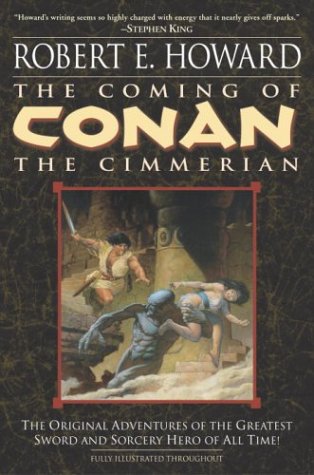 Robert E. Howard created one of the most iconic and enduring heroes in Conan the Barbarian. We're big fans of the sword-welding brute at DaRK PaRTY - as you may have gathered from our recent interview about Conan with Joakim Zetterberg.
Robert E. Howard created one of the most iconic and enduring heroes in Conan the Barbarian. We're big fans of the sword-welding brute at DaRK PaRTY - as you may have gathered from our recent interview about Conan with Joakim Zetterberg.Joakim and his compay Paradox Entertainment (which owns the rights to Conan) have offered DaRK PaRTY readers a chance to win a free edition of "The Coming of Conan the Cimmerian: The Original Adventures of the Greatest Sword and Sorcery Hero of All Time" by Robert E. Howard.
This 463-page tome collects many of Howard's original Conan tales in one book. Why not listen to Stephen King? He says, "Howard's writing seems so highly charged that it nearly gives off sparks."
We asked folks to pick who they would like to play Conan in the upcoming 2010 movie. At random, we selected three winners. You should expect the book in the mail soon. The winners are:
- Steven F. from Bunaby, British Columbia
- Bill C. from Alvin, Texas
- Jay B. from Houston, Texas
Thanks to everyone who entered and see you at the next book giveaway!
Labels: Conan, Contest, Dark Party
 StumbleUpon |
StumbleUpon |
 del.icio.us |
del.icio.us |
 Technorati |
Technorati |
Thursday, January 22, 2009
5 Questions About: Edgar Allan Poe
An Interview with Professor Paul Lewis About the Legacy and Life of Poe
(It our continuing celebration of Edgar Allan Poe’s 200th birthday, we reached out to Professor Paul Lewis. Paul, an English professor at Boston College, organized the celebration of the Poe bicentennial in Boston. Those with long memories might recall that we interviewed Paul before about modern humor and his book “Cracking Up: American Humor in a Time of Conflict.” Paul teaches Poe (and others) in his role as a teacher of American literature. He recently wrote an op-ed in the Boston Globe about Poe and his relationship with Boston called “Evermore: The Enduring Legacy of Edgar Allan Poe.” Despite his busy schedule, Paul gave us a crash course on Mr. Poe.)
 DaRK PaRTY: Edgar Allan Poe was born in Boston, yet he's rarely associated with the city. Why is that?
DaRK PaRTY: Edgar Allan Poe was born in Boston, yet he's rarely associated with the city. Why is that?Paul: Poe's parents moved from Boston to Richmond a few months after he was born. He returned after leaving the University of Virginia to enlist in the army and served for a few months at Fort Independence before moving south again.
In 1845, after years of critical combat with New England writers, Poe delivered a lecture at the Boston Lyceum. Local critics panned his performance, and Poe struck back in a series of insulting essays published in The Broadway Journal, which he was then editing. He called Bostonians "Frogpondians," said our hotels were "bad" and our poetry "not so good."
But it's too easy to see Poe's differences with Boston as a matter of purely personal pique. On the contrary, his rejection of the didacticism of New England writers, including Emerson and Longfellow, allowed Poe to arrive at the radical view that poetry and fiction should affect (i.e. powerfully move) readers rather than persuade them. That beauty was more important than truth as an end for literature. Arriving at this emphasis on effects allowed Poe to become a foundational figure in the development of popular culture.
For an overview of the Poe-Boston relationship, see the Boston College library exhibit "The Raven Returns: Poe and the City of Boston, 1809-2009."
DP: Baltimore has claims on Poe, yet he spent more time in Richmond, New York and Philadelphia. What geography do you think had the biggest influence on his writing?
Paul: Many of Poe’s contemporaries Americanized their stories by situating characters in familiar landscapes and historical contexts. Cooper set his warriors loose in the forests of New York. Hawthorne wrote about the world he knew in Boston and Salem. Melville launched his great sea tale from Nantucket. Thoreau “traveled much in Concord.” And even Whitman, who peered around the planet and out into space, was mostly interested in the new nation as a source of democratic vistas.
Although it can often be difficult to see where Poe’s stories are set, their place in the formation of an American mythos is clear. From the start in thinking about fiction, Poe had in mind something like Tocqueville’s observation that democracy focuses attention on the individual. Though some of the dark tales are set in named places (London, the Hudson River Valley), many of them exist inside a single mind responding to dangerous mysteries. This is the landscape he explored.
DP: Poe is often maligned by the literary elite and often dismissed as a hack. Does Poe deserve to be regarded as one of the great American writers? Why?
 Paul: Edgar Allan Poe hovers over American culture like his raven: brooding, scowling, and winking. Arguably the most influential of our great writers, he has been condescended to by highbrow authors. Emerson called him the “jingle man.” T. S. Eliot said he had a pre-pubescent intellect. Yeats saw him as “vulgar and commonplace.” With detractors like these, no wonder his stories are so much fun!
Paul: Edgar Allan Poe hovers over American culture like his raven: brooding, scowling, and winking. Arguably the most influential of our great writers, he has been condescended to by highbrow authors. Emerson called him the “jingle man.” T. S. Eliot said he had a pre-pubescent intellect. Yeats saw him as “vulgar and commonplace.” With detractors like these, no wonder his stories are so much fun!Best known for a few images—a dead man’s still-beating heart, a decaying mansion falling into its reflecting tarn, a bricked-up, corpse-concealing wall, and, of course, a black cat—Poe’s work is about far more than mere terror.
Poe was our first great critic. In an age of pious reform, he insisted that literature should primarily move (or affect) readers, not inculcate truths. The author of political and social satires, hoaxes and parodies, a long nonfiction study of cosmology and a short novel about polar exploration—he ranged across genres available to him and expanded the list by creating the modern detective story and greatly enriching what the gothic could achieve.
Poe understood what mass audiences desire. The father of the psychological thriller, he has influenced every later writer in the genre from Bram Stoker to Stephen King and Ann Rice. Every pre-human creature H. P. Lovecraft kept in shadow, every inexplicable disruption that detaches Hitchcock’s heroes from their normal lives, every debate between Scully and Mulder, every monster seen through the shaking lens of a camcorder owes a debt to Edgar.
Unfortunate childhood experiences (most notably the early loss of both parents) left Poe with an abiding sense of life as random and cruel but also absurdly comic. Moving beyond the predictability of mind-numbing fear, his genius flashes in moments when responses to the unknown collide and something terrifying suddenly seems funny or vice versa. The speaker’s shifting moods in “The Raven” (1845) are typical. Brooding and isolated when the creature knocks, he moves through denial to attempts to laugh off his concern to an effort to explain what is happening rationally to mournful despair.
DP: What three works of Poe's do think showcase his talents better than any others and why?
Paul: “The Premature Burial” (1844), “Hop-Frog” (1849), and “The Sphinx” (1846). Each of these tales draws on Poe's keen awareness of the proximity of humor to fear, a sensibility that allowed him to work within and make fun of popular genres simultaneously.
DP: Poe's death is shrouded in mystery. He died in Baltimore, yet no one is sure why he was there. He seemed to be wearing someone else's clothing and he shouted a man's name out at the hospital he was taken in delirium before he died. What do you think happened to Poe just before his death?
Paul: No one knows, but however he died does not cast a favorable light on Baltimore!
Did Edgar Allan Poe Write the First Modern Zombie Story?
Great Openings: The First Sentences of 10 Classic Poe Short Stories
Poe: The Mad and Bad Writings of a Genius
Labels: Edgar Allan Poe, interview, literature, Paul Lewis
 StumbleUpon |
StumbleUpon |
 del.icio.us |
del.icio.us |
 Technorati |
Technorati |
Tuesday, January 20, 2009
Celebrating America in Art
Inauguration Special: America Through the Eyes of its Most Iconic Art
What better way to honor the Inauguration of Barack Obama as the 44th president of the United States than to look back on the most famous paintings and artwork in U.S. history? Here are some of DaRK PaRTY’s favorite American iconic images.
American Gothic
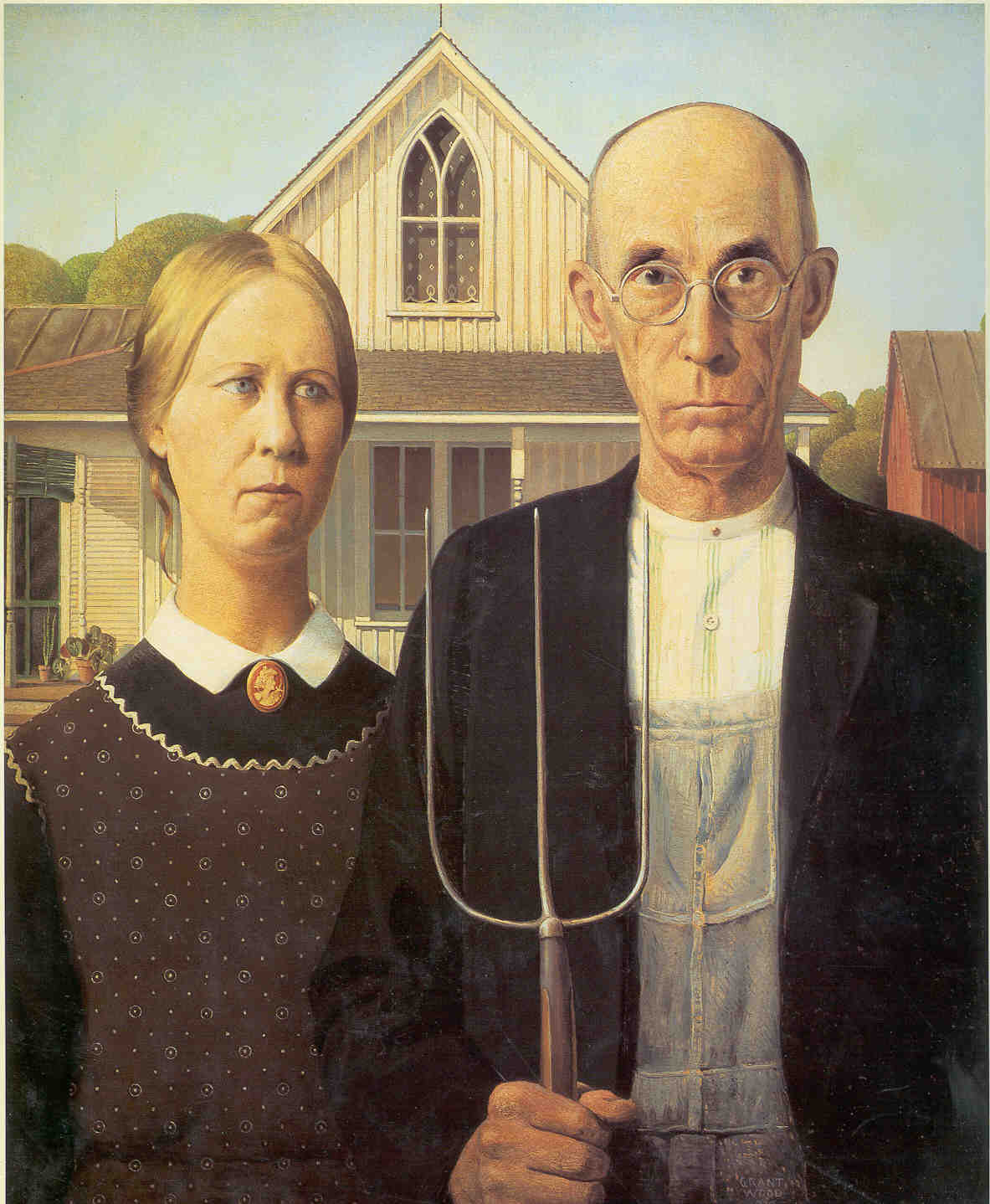
Grant Wood painted “American Gothic” in 1930 as the United States was entering the Great Depression. The severe expressions on the face of the older man (modeled by Grant’s dentist) and the younger woman (Grant’s sister) seem to capture the essence of austere, hard-working Middle America. The painting is one of the most famous images in the world and one of the most parodied.
Whistler’s Mother

The actual name of the painting is “Arrangement in Gray and Black: Portrait of the Artist’s Mother.” Another painting that captures the harsh plainness of the American Mid-West. James Abbott McNeill Whistler painted it in 1871.
Portrait of Madame X

John Singer Sargent’s portrait of a French socialite Virginie Amelie Avegno Gautreau, rumored to be one of the most beautiful women in Paris (and legendary for her alleged infidelities). The painting captures Madame X’s personality and her contradictions. It was painted in 1884. Could only a "vulgar" American have painted it at the time?
Washington Crossing the Delaware
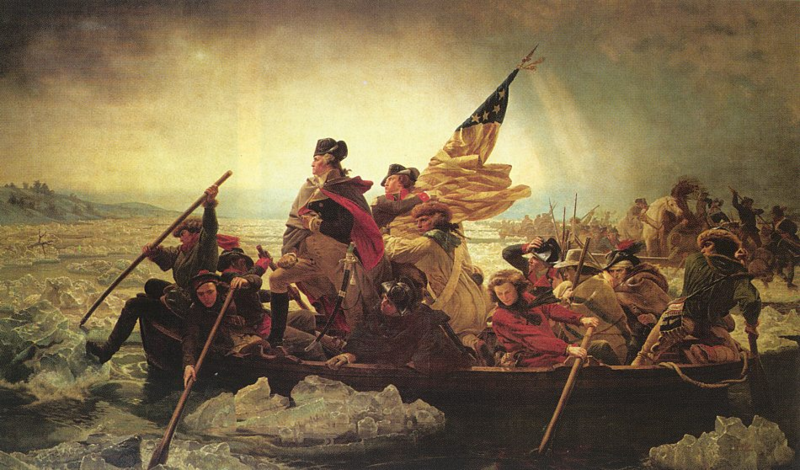
An 1851 oil painting by Emanuel Leutze celebrates Washington’s historic Christmas crossing of the icy Delaware River on his way for a surprise attack on the British at Trenton in 1776. The painting is notable for the way the sun breaks through the clouds and illuminates Washington’s face. The crew represents a cross-section of America.
The Oxbow

This painting by Thomas Cole is actually called “View from Mount Holyoke, Northhampton, Massachusetts, after a Thunderstorm.” It was painted in 1836 and encapsulates the two Americas of the time: the dark wilderness and the sunny civilization tamed by the settlers.
Breezing Up (A Fair Wind)

The American spirit for adventure and daring is represented in this painting of a father and his sons out sailing in a stiff wind. It was painted in 1876 by Winslow Homer.
Morning Sun

If Edward Hopper had been a fiction writer, he would have been Raymond Carver. Hopper depicted the loneliness and complexity of American culture in the shadow and light of his portraits. His most famous work is “Night Hawks,” but we love “Morning Sun,” which was painted in 1952.
Christina’s World
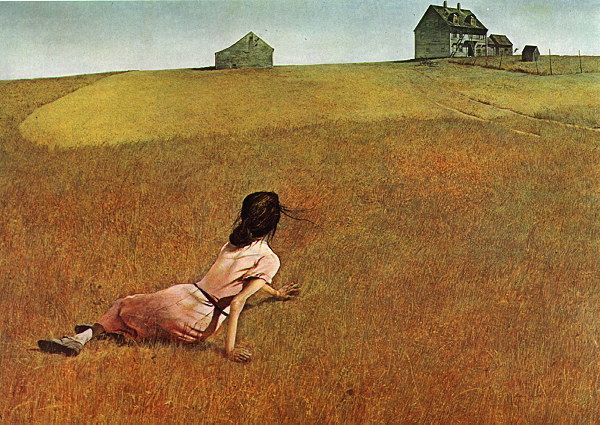
This 1948 painting by Andrew Wyeth (who recently died) depicts a young woman in an open field in Maine looking back at a gray house and barn in the distance. The woman actually suffered from a disease and couldn’t walk, yet the painting seems to capture her longing for her home.
The Problem We All Live With

Does any image capture our Civil Rights era and school integration better challenges than Norman Rockwell’s “The Problem We All Live With” painted for Look Magazine in 1964?
Campbell’s Soup

Andy Warhol’s 1968 painting of a Campbell’s Soup can (tomato) nails the idea of iconic American culture in one fell swoop. The simplicity of the work doesn’t speak to the complexity of what it says about the transformation of America in the 1960s.
7 Photographs That Changed the World
Media Critic Dan Kennedy Analyzes the Intersection of Politics & Media in the 2008 Election
Essay: The "W" Stands for Wicked Bad
 StumbleUpon |
StumbleUpon |
 del.icio.us |
del.icio.us |
 Technorati |
Technorati |
Friday, January 16, 2009
DP's Magical Mystery Tour #5
DaRK PaRTY Wins Coveted Dardos Award
Media Alerted, Obama Sends Citation, U.N. to Hold Parade
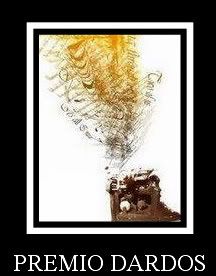
BOSTON _ The DaRK PaRTY ReVIEW, the elite cultural and literary blog setting the standard for quality and typos, today announced that it was awarded the coveted Dardos Award (whatever that is). The award was bestowed on DaRK PaRTY by Flickhead, a cinema and film blog that likes to post pictures of hot-looking actresses to drive up image searches to its site.
The award is described as:
“The Dardos Award is given for recognition of cultural, ethical, literary, and personal values transmitted in the form of creative and original writing. These stamps were created with the intention of promoting fraternization between bloggers, a way of showing affection and gratitude for work that adds value to the Web.”
Award winners are also required to have a pulse.
"I'm thrilled," said GFS3, editor and publisher of DaRK PaRTY. "After getting our asses ground up like rotten hamburger in the recent voting for the 2008 Weblog Award for Best Culture Blog, this honor may help us save face. I won't bore you with the details of the rigged voting on the Weblog Awards. Everyone knows they're all bastards over there anyway."
In his acceptance speech in front of his hallway mirror (unshaven and still wearing pajamas), GFS3 heaped praise and gave his five nominations for blogs that he thinks deserve the distinction of a Dardos Award. DaRK PaRTY's list of five blogs are as follows:
Ward 6: One of the most literate, fascinating reads on writing and fiction that you'll find on the Internet. Every time I visit, I get lost in the beautiful writing and thoughtful analysis.
So Many Books: Another book blog that is simply elegant. The passion for the reading life lifts "write" off the screen.
Bill Crider's Pop Culture Magazine: It doesn't get much funnier than Bill's observations about culture: crime, literature, and celebrities. A daily stop for me.
Zombo's Closet of Horror: If you love horror fiction and movies then this should be a place you visit early and often!
Madam Miaow Says: My new favorite blog even though she kicked my butt in the 2008 Weblog Award for Best Culture Blog. Great writing with a strong voice. What's not to love?
"Yes, I understand that this is like a bad chain letter," GFS3 said. "But that's what society has wrought when it created the Internet. Well, that and easy access to adult entertainments like pornography, gambling, and illegal prescription drug sales."
The five nominees from DaRK PaRTY are now required to acknowledge their Dardos Award on their blogs (and the fact that it came from yours truly) and hand it out to five others who are worthy. This will mean, of course, that every blog on the Internet will win eventually, but let's not get caught up in the ridiculous details.
--30--
Labels: Dark Party, Magical Mystery Tour
 StumbleUpon |
StumbleUpon |
 del.icio.us |
del.icio.us |
 Technorati |
Technorati |
Thursday, January 15, 2009
Did You Win "The Beautiful Cigar Girl"?
Did You Win a Copy of "The Beautiful Cigar Girl"?
DaRK PaRTY is celebrating the 200th birthday of Edgar Allan Poe (Poe was born on January 19, 1809) by giving away a hardcover copy of Daniel Stashower's magnificent non-fiction book "The Beautiful Cigar Girl: Mary Rogers, Edgar Allan Poe, and the Invention of Murder."
 Stashower explores the mysterious murder of Mary Rogers, a celebrated beauty who worked in a tobacco shop in Manhattan. She was the Paris Hilton of her day -- famous for her looks and charm. Her strangled and drowned corpse was pulled out of Hudson River in 1841. The murder was the fodder for the penny press newspapers in New York City for months.
Stashower explores the mysterious murder of Mary Rogers, a celebrated beauty who worked in a tobacco shop in Manhattan. She was the Paris Hilton of her day -- famous for her looks and charm. Her strangled and drowned corpse was pulled out of Hudson River in 1841. The murder was the fodder for the penny press newspapers in New York City for months.Poe, struggling with his own demons, decided to try and solve the case through fiction using his analytical detective C. Auguste Dupin. It resulted in Poe's famous short story "The Mystery of Marie Rogêt."
Stashower combines the story of Poe's life and how it intersects with the Rogers' murder. The book is an amazing read for anyone interested in Poe and his work. Stashower avoids the cliches that often accompany biographies of Poe and paints a portrait of an artistic genius that was his own worst enemy.
We asked people to tell us their favorite Poe story and then to send us an email with their name and address to enter. We held a random drawing and now have a winner. Drum roll, please! The winner is:
Francine A. from Omaha, Nebraska
Francine has been set a copy of the book. Happy reading, Francine, and thanks to everyone who entered. We'll be holding a new book giveaway next week so please stay tuned!
And, of course, Happy birthday, Mr. Poe!
Labels: Contest, Dark Party, Edgar Allan Poe
 StumbleUpon |
StumbleUpon |
 del.icio.us |
del.icio.us |
 Technorati |
Technorati |
Great Openings: Edgar Allan Poe Edition
The First Sentences to 10 Classic Poe Short Stories and One Poem
The Murders in the Rue Morgue
“The mental features discoursed of as the analytical, are, in themselves, but little susceptible of analysis.”
The Purloined Letter
“At Paris, just after dark one gusty evening in the autumn of 18__, I was enjoying the twofold luxury of mediation and meerschaum, in company with my friend, C. Auguste Dupin, in his little black library, or book-closet, au troisieme, No. 33 Rue Dunot, Faubourg St. Germain.”
The Black Cat
“For the most wild yet most homely narrative which I am about to pen, I neither expect nor solicit belief.”
The Fall of the House of Usher
“During the whole of a dull, dark, and soundless day in the autumn of the year, when the clouds hung oppressively low in the heavens, I had been passing alone, on horseback, through a singularly dreary tract of country, and at length found myself, as the shades of the evening drew on, within view of the melancholy House of Usher.”
The Pit and the Pendulum
“I was sick—sick unto death with that long agony; and when they at length unbound me, and I was permitted to sit, I felt that my senses were leaving me.”
The Masque of the Red Death
“The ‘Red Death’ had long devastated the country.”
The Cask of Amontillado
“The thousand injuries of Fortunato I had borne as I best could; but when he ventured upon the insult, I vowed revenge.”
The Tell-Tale Heart
“True!—nervous—very, very dreadfully nervous I had been and am; but why will you say that I am mad?”
Manuscript Found in a Bottle
“Of my country and of my family I have little to say.”
A Descent into the Maelstrom
“We had now reached the summit of the loftiest crag.”
The Raven
“Once upon a midnight dreary, while I pondered, weak and weary,/ Over many a quaint and curious volume of forgotten lore—/ While I nodded, nearly napping, suddenly there came a tapping,/ As of some one gently rapping, rapping at my chamber door.”
The Mad and Bad Writings of Edgar Allan Poe
Literary Criticism: The Masque of the Red Death
Great Openings: Mystery Edition
Labels: Edgar Allan Poe, Great Openings, literature
 StumbleUpon |
StumbleUpon |
 del.icio.us |
del.icio.us |
 Technorati |
Technorati |
Tuesday, January 13, 2009
5 Questions About: Conan the Barbarian
An Interview About the Legendary Barbarian Created By Robert E. Howard
“Crom, I have never prayed to you before. I have no tongue for it. No one, not even you, will remember if we were good men or bad. Why we fought, or why we died. All that matters is that two stood against many. That's what's important! Valor pleases you, Crom... so grant me one request. Grant me revenge! And if you do not listen, then to hell with you!”
- Arnold Schwarzenegger as Conan
(The best part of Arnold Schwarzenegger as Conan in the two films made in the 1980s was that he looked like the iconic barbarian warrior. Unfortunately, Schwarzenegger played Conan like a brutish ape and left the complexities of the character out in the cold. Conan the Barbarian was complicated – tough, merciless, but also with a keen intelligence and a wry sense of humor. Conan has become a mythical fictional character in the same category as Sherlock Holmes, Dracula, and Peter Pan. Most people recognize Conan even if they’ve never read the stories by pulp writer Robert E. Howard, who created the Cimmerian warrior in 1932. DaRK PaRTY recently rediscovered the joy and wonder of Howard’s Conan (and eagerly awaits the new movie which could happen in 2009). We decided we needed more and sought out Joakim “Jay” Zetterberg, director of publishing at Paradox Entertainment (the company that owns the rights of Howard’s library of work – including the mighty Conan.)
 DaRK PaRTY: How would you describe Conan in personality and in appearance?
DaRK PaRTY: How would you describe Conan in personality and in appearance?Joakim: Uncompromising with a strong moral fiber. Impressive physical stature and strong as an oxe, yet lithe as a panther.
DP: What is the biggest misconception about Conan?
Joakim: While stuck with the epithet "Barbarian" I find him being far from it. Yes, he beats up quite a lot of people but we all know they deserve it. He has a very straight-forward moral code which is easy to understand. He does what he has to do to survive which is more or less a combination of common sense and taking matters into his own hands. He only makes a couple of moral sidesteps with today's standards, like when he needs money for food. But barbarian, nope.
DP: Conan has become an iconic fictional character. Why do you think Conan appeals to so many people around the world?
Joakim: He does what many people would like to do, to live a free and adventurous life, to act on instinct and do unto other what they do to him. Imagine what Conan would do to the telemarketers of today.
DP: If you had to pick three of Robert E. Howard's Conan stories that really encapsulate the Conan mythos, which ones would they be and why?
 Joakim: As my personal favorites I would start with "Frost-Giant's Daughter." It hardly begins before it ends and leaves me intrigued because it is so open-ended. What place is this, who is this Conan, where did he come from, where is he going? "Queen of the Black Coast" for showing that Conan is not only a sword-slinging brute. And of course "Hour of the Dragon', the only novel-length Conan story, featuring an older Conan on the throne of Aquilonia. From battlefield to king. That's quite a journey.
Joakim: As my personal favorites I would start with "Frost-Giant's Daughter." It hardly begins before it ends and leaves me intrigued because it is so open-ended. What place is this, who is this Conan, where did he come from, where is he going? "Queen of the Black Coast" for showing that Conan is not only a sword-slinging brute. And of course "Hour of the Dragon', the only novel-length Conan story, featuring an older Conan on the throne of Aquilonia. From battlefield to king. That's quite a journey.DP: Do you think the two Conan films starring Arnold Schwarzenegger captured the true spirit of Conan? What did you like best about the films and what didn't work in your opinion?
Joakim: If by capturing the true spirit of Conan you mean being true to Conan as Robert E. Howard described him then there is something missing. Conan is more complex than how he is portrayed in the movie. However, the movies are iconic and whatever your opinion is of them they brought Conan back into the spotlight after some years of waning interest after the huge surge in popularity with the Frazetta paperbacks in the 1960s. We should all be thankful for that.
The Toughest SOBs in Fantasy Fiction (includes Conan)
The Legends of Literature (includes Conan)
5 Questions About: Sherlock Holmes
Labels: 5 Questions, Conan, interview, Joakim Zetterberg, Robert E. Howard
 StumbleUpon |
StumbleUpon |
 del.icio.us |
del.icio.us |
 Technorati |
Technorati |
Monday, January 12, 2009
Comic Noir
The Rise of the Comic Book Crime Novel
After recently reading “Severance Package” by Duane Swierczynski and “Beat the Reaper” by Josh Bazell, DaRK PaRTY has identified a new genre in book publishing that – until now – has gone nameless. We also include Victor Gischler’s novels (like “Go-Go Girls of the Apocalypse”) in this new category.
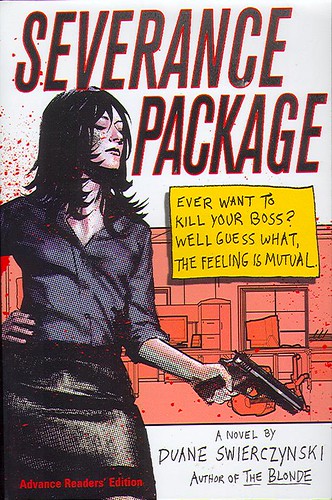 Let’s call it Comic Noir.
Let’s call it Comic Noir.Comic Noir combines the elements of a graphic novel – most notably superhero comics by Marvel and DC – and incorporates them into the plot structure and dark themes of classic crime noir such as those written by Jim Thompson and James M. Cain.
This mix provides a vastly entertaining, completely ridiculous crime farce that has a tendency to take itself too serious while being laugh-out loud funny at the same time. Comic Noir novels generally are fast reads, feature huge build-ups, and then implode into groan-inducing, far-fetched conclusions.
But they are fun reads, if forgettable after a few weeks. They are the snack food aisle of literature. Tasty and with a great sugar high! They have also become the new darlings of book publishers and book reviewers.
DaRK PaRTY has identified six core components of the Comic Noir novel. Here they are:
1. Comic Noir books inevitably get compared to Quentin Tarantino films.
• In the review of “Go-Go Girls from the Apocalypse,” the New York Times called the book “Part Christopher Moore, part Quentin Tarantino…”
• In its review of “Severance Package,” Booklist gushed, “This is essentially one long action scene that begs for the next Tarantino to direct.”
• Also on “Severance Package,” the Chicago Tribune said: “…enough gut-churning violence to make a Quentin Tarantino movie look like a Disney musical…”
 2. Comic Noir features “high-concept” plots generally found in comic books. The more outlandish the better!
2. Comic Noir features “high-concept” plots generally found in comic books. The more outlandish the better!• “Severance Package” is about the boss of a shell corporation that is really a covert spy agency calling all of its employees to work on a Saturday, trapping them on the corporate floor by rigging explosives to the exits, and then trying to execute all of them.
• “Beat the Reaper” is about a mafia hitman in the Federal Witness Protection Agency now working as an intern at a hospital being forced to operate on and save the life of a mob stoolie or face being revealed to his mafia enemies.
3. Expect a lot of unrealistic, over-the-top comic book violence with few if any emotional consequences.
• Our favorite: The protagonist from “Beat the Reaper” rips his fibula bone from his calf and uses it to stab to death a room full of heavily armed mobsters.
4. Comic Noir resembles bad Westerns when it comes to gun play: one bullet from the good guy always hits its mark while machine guns and heavily artillery in the hands of many bad guys always miss. And bullet wounds in the extremities are easily fixed in Comic Noir novels by wrapping a piece of clothing around the wound. Yet, guns ultimately don’t get the job done and hand-to-hand fighting is required.
 5. The protagonists are generally sociopathic criminals (can you say “hitman”?) who are funny and sarcastic, and, despite being sociopaths, don’t seem to have any sexual hang-ups.
5. The protagonists are generally sociopathic criminals (can you say “hitman”?) who are funny and sarcastic, and, despite being sociopaths, don’t seem to have any sexual hang-ups.• The main character from Victor Gischler’s “Gun Monkey” is Charlie “The Hook” Swift” a mob enforcer and hitman.
• The protagonist from “Beat the Reaper” is Pietro “Bearclaw” Brnwa a former hitman for the mob.
6. Comic Noir treats female characters in much the same way as the comic book industry draws them (think Power Girl and Wonder Woman) – oozing sex appeal, scantily clad, and ready to punch you in the face (or shoot you in the back).
Please feel free to add any authors or observations about Comic Noir to our comments section.
Our review of "Beat the Reaper"
Our review of "Severance Package"
5 Questions About: Crime Noir
Labels: Comic Noir, Crimes, Duane Swierczynski, Fiction, Josh Bazell, Victor Gischler
 StumbleUpon |
StumbleUpon |
 del.icio.us |
del.icio.us |
 Technorati |
Technorati |
Thursday, January 08, 2009
Cracked-Back Book Reviews: January 2009
(Rapid-fire reviews of the books we’ve been cooking in the oven and then eating with a fine red table wine. And, of course, a “cracked-back” is what happens to the spine of a new book once you’ve thoroughly de-boned it. We’re always looking for our next read, so please feel free to make your own recommendations in our comments section. Read on!)
Beat the Reaper
By Josh Bazell
 Josh Bazell, a newly minted doctor, received a seven-figure deal for “Beat the Reaper,” his debut crime novel that he wrote while an intern. Unfortunately, it’s difficult reading “Beat the Reaper” and not dwell on that enormous payday. It’s much like watching an overpaid baseball player – he’s good, but is he that good?
Josh Bazell, a newly minted doctor, received a seven-figure deal for “Beat the Reaper,” his debut crime novel that he wrote while an intern. Unfortunately, it’s difficult reading “Beat the Reaper” and not dwell on that enormous payday. It’s much like watching an overpaid baseball player – he’s good, but is he that good?The good news is that “Beat the Reaper” is a nasty, little crime caper. It’s a crime farce with a cynical attitude and a slick style. The best part of the book is the first-person narrative voice of protagonist Dr. Peter Brown, a.k.a. Pietro “Bearclaw” Brnwa. Brown was once a mafia hitman and is currently in the Federal Witness Protection program studying to be an MD.
That’s where the reader lands in the story. One of Brown’s patients recognizes him. The deal is that Brown helps the patient live through his operation or one of his associates rats out Brown to the mafia family looking to take him out. It’s a delicious, wacky journey of cutthroat encounters with Russian gangsters, Italian wise guys, cranky nurses, desperate patients, and even a tank filled with man-eating sharks.
The one unfortunate part of “Beat the Reaper” is the ridiculous ending. It’s so improbable that you’ll find yourself rolling your eyes and groaning. But luckily Bazell has built up enough goodwill through is witty, stabbing style that you’re willing to forgive him for it.
“Beat the Reaper” is a blast (check out the video above) – a guilty pleasure (kind of like eating at a fast food joint). You’ll love it while your reading it (sans the conclusion), but you probably won’t remember reading it in six months.
Grade: B+
Lost River
By David Fulmer
 The fourth book in the Valentin St. Cyr mystery series by David Fulmer (who, as an aside, looks separated from birth from TV ringleader Jerry Springer). The mystery takes place in steamy New Orleans of 1913 in the red-light district called Storyville. Fulmer is a master of creating place – and readers will feel like they’ve been transported back in time. Storyville lifts off the pages and into the reader’s imagination. You can smell the seedy tap houses and jazz joints. You can feel the hot, sticky humidity.
The fourth book in the Valentin St. Cyr mystery series by David Fulmer (who, as an aside, looks separated from birth from TV ringleader Jerry Springer). The mystery takes place in steamy New Orleans of 1913 in the red-light district called Storyville. Fulmer is a master of creating place – and readers will feel like they’ve been transported back in time. Storyville lifts off the pages and into the reader’s imagination. You can smell the seedy tap houses and jazz joints. You can feel the hot, sticky humidity.The writing is beautiful. The prose rolls like jazz music and Valentin St. Cyr fans will welcome “Lost River” into the series.
However, there are some stumbling blocks in storyline. The first is the mystery itself. It’s like a street map that can’t be refolded correctly. The traveler tries to retrace the proper steps, but ends up with new creases and folds and finally out of frustration stuffs the map back into the glove box. The mystery – which has to do with a series of murders to take over Storyville – has too many logic lapses to make much sense.
One of the most disappointing details gone wrong is that St. Cyr has his regular pistol (the Iver Johnson) confiscated by the police and is forced to use a backup. Yet at the end of the novel, his regular pistol is back in his hands for the final confrontation. No explanation is ever given (Fulmer should reprimand his editor for the mistake getting into print).
There’s also a sense that Fulmer likes his main character just a bit too much. St. Cyr is a living legend in Storyville and Fulmer is only too happy to show us how he’s worshipped. Yet even with these two challenges, “Lost River” is a solid entry and a good read for anyone who enjoys historical mysteries.
Grade: B-
Too Late To Die
By Bill Crider
 “Too Late To Die” is the first novel in the long-running Sheriff Rhodes mystery series by the delightful Bill Crider (if you haven’t visited his must-read Pop Culture blog – then what are you waiting for?). The Dan Rhodes series is like potato chips – once you have one you can’t stop.
“Too Late To Die” is the first novel in the long-running Sheriff Rhodes mystery series by the delightful Bill Crider (if you haven’t visited his must-read Pop Culture blog – then what are you waiting for?). The Dan Rhodes series is like potato chips – once you have one you can’t stop.They don’t write mysteries like “Too Late To Die” anymore. This one was published back in 1989 when there was such a thing as the Soviet Union and Milli Vanilli was the “it” pop rock group. “Too Late To Die” is a character driven mystery that takes place in rural Texas. It’s filled with interesting people – quirky, flawed, and always fascinating.
Sheriff Dan Rhodes, a middle-aged widower, is up for re-election in Blacklin County, Texas. And just in time for the campaign comes the murder of a young wife – who appears to have been mighty popular with a lot of men other than her husband. As Dan investigates, the roll of suspects starts to get rather large: a cranky storeowner, a homeless half-wit, a religious zealot, and his rival candidate for sheriff.
The mystery unfolds in rural Texas style – languidly until it gets fast and furious. But really the mystery (which has a satisfying array of twists and turns) is just an excuse to explore the eccentric nature of the characters. It’s these interactions, dialogue, and portraits that bring Blacklin County to life and make “Too Late To Die” so fun to read.
Grade: A-
Cracked-Back Book Reviews: November 2008 (Graphic Novel Special!)
Book Review: "Runner" Will Leave You Breathless
Comic Books for Literature Professors
Labels: Bill Crider, book review, Cracked-Back, David Fulmer, Josh Bazell, mysteries
 StumbleUpon |
StumbleUpon |
 del.icio.us |
del.icio.us |
 Technorati |
Technorati |
Wednesday, January 07, 2009
Essay: The Twilight of Reading
Reading and Writing Are Under Attack By Technology That Enables Verbal Communication to Thrive
“There are two motives for reading a book: one, that you enjoy it; the other, that you can boast about it.”
- Bertrand Russell

It is always assumed that reading and writing are basic skills necessary for success in business, academics, and in life. This is, of course, because written language has been the backbone of societal communication for more than a thousand years.
But will this always be true? Have we already entered the twilight of written communications? Is reading doomed to extinction?
After all, written language is a substitute for verbal communication. While children instinctively learn spoken languages – the same is not true for written languages. Writing and reading are manmade inventions and must be learned.
So what happens if no one wants to learn them anymore?
Imagine a world where writing and reading have become unnecessary. All information is conveyed through verbal communication – through video or audio feeds (made possible by technology and the internet). For example, computers would communicate driving instructions and road rules directly to drivers making “traffic signs” pointless. Books, novels, manuals, recipes, bills, letters, etc. are replaced with video and audio files as thin as paper that speak to users (and even answer questions through voice recognition software).
In this world when a consumer buys a new HD-TV at Best Buy, the box the television arrives in has a built in video display that shows the buyer how to set-it up (with easy to follow demonstrations – that can even go in slo-mo). The box will answer simple questions and for more complicated problems it will quickly hook up to the Internet for more comprehensive video and audio capabilities.
How about credit card bills that arrive on paper and are actually touch screen computers? The “paper” will tell the recipient how much they owe, balance information, offers for new products and services, and even allow them to ask questions and perform simple commands – like bill payment and change of address.
This is a world where speech becomes the primary form of communication and super smart portal devices (hello, iPhone) become the main tools in the exchange of ideas. When products – when things – can freely and intelligently interact with people, why will written communication be necessary?
In this world, writing and reading will go the way of Latin – the sole providence of intellectuals and academics.
Farfetched?
Not if you consider the sorry state of literacy in our modern world. Computers and TV screens have already encroached on writing and reading. Literacy rates in the United States have been in fast decline for more than a decade. Consider the evidence:
- The National Assessment of Adult Literary found a steep drop in reading proficiency among college graduates during the 1990s. In 1992, 40 percent of college graduates scored “proficient” in literary, but one year later in 1993, the number dropped by 9 percent (to 31 percent).
- A 2004 study by the National Endowment for the Arts found that more than half of all U.S. adults don’t read any literature. The study also found that from 1982 to 2002 more than 20 million people stopped reading books for pleasure.
- A follow-up to the NEA report in 2007 found that 15-24 year olds watched TV on average two hours a day, but read less than 7 minutes per day. The report also found reading proficiency in that same age group fell 20 percent between 1992 and 2003.
Keep in mind that this decline is mostly voluntary. The United States has already reached the point where people don’t want to read for pleasure anymore. Video games have replaced comic books. Movies have replaced novels. The Internet has replaced reference books.
Reading and writing have been pushed out of households and into offices – but once email is replaced with speech mail and presentations become video conversations – reading and writing will begin to lose their hold on that venue as well. Hasn’t Powerpoint presentations already eroded thoughtful written discourse in favor of bullet points?
Once alternatives to reading and writing – made possible by the web and technology – become readily available, why won’t people completely abandon written language and return to the truest and easiest form of communication: verbal communication?
Nothing lasts forever. Just ask struggling book publishers. In a country with more than 300 million people – a bestseller is now considered a book that sells about 100,000 copies.
Is literacy standing on thin ice? Have we entered into the twilight years of reading and writing?
It’s scary to think so.
Fixing Our Reading Problem
Poetry Smells Like Talcum Powder
5 Questions About: Getting Published
Labels: Essay, literature, reading
 StumbleUpon |
StumbleUpon |
 del.icio.us |
del.icio.us |
 Technorati |
Technorati |
Tuesday, January 06, 2009
Comics for Literature Professors
10 Obscure Comic Book Villains and Heroes Inspired by Literature or Mythology
In Marvel Team-Up #48, Spiderman teams up with Ironman to fight the mysterious Wraith. Befuddled by who is randomly bombing targets in New York, Spiderman and Ironman join forces with Police Captain Jean DeWolff. As DeWolff discusses the case, Spiderman mutters:
“Curiouser and curiouser.”
This, of course, is a quotation from Alice uttered in the classic novel “Alice’s Adventures in Wonderland.”
It’s moments like this when fans of comic books chuckle. Comic books have always referenced classic works of fiction. In fact, many comic heroes and villains have been directly inspired by literature and mythology.
There are the obvious ones: Thor, Hercules and Conan the Barbarian come immediately to mind. Then came “The League of Extraordinary Gentlemen,” the graphic novel that combined the mythology of superhero comics with literary characters (watch a clip from the movie above). The mash-up featured Captain Nemo, Dr. Jekyll & Mr. Hyde, the Invisible Man and even Tom Sawyer.
But there are a lot of comic books characters that are lifted directly from mythology and literature that are a little less familiar. Here is DaRK PaRTY’s list of our 10 favorite comic book heroes stolen from the pages of your college literary textbook.
Icarus

Publisher: Marvel Comics
First Comic Appearance: Rom Annual #3
The Comic Character: Icarus is a human mutant with the power of flight. He does, after all, have red bird-like wings growing out of his back. He can fly and has an extensive regenerative powers to heal from normally fatal injuries.
Literary Inspiration: The Greek myth of Icarus is that he the son of Daedalus. Father and son try to escape from exile from the island of Crete by fashioning bird wings made of feathers and wax. Daedalus warns Icarus not to fly too close to the sun or the wax would melt his wings. Caught in the exhilaration of flight, Icarus ignores his father’s warning and plummets to his death.
Literary Origin: From the poem in Pseudo-Apollodorus, but made popular by Ovid in the 15th century.
 Tar Baby
Tar BabyPublisher: Marvel Comics
First Comic Appearance: Power Pack vol. 1 #12 (1985)
The Comic Character: Tar Baby is a human mutant that could secrete a tar-like substance from his skin. This allowed Tar Baby the ability to stack to anything that came in contact with him. The character wore raggedy purple trousers with patches and a rope belt and had black skin.
Literary Inspiration: The story of Tar Baby comes from African-American folklore. The tale has Br’er Fox and Br’er Bear build a doll out of tar (dressed in old rags) to capture Br’er Rabbit. When Br’er Rabbit talks to Tar Baby and it doesn’t answer he gets angry and starts to hit and kick it – only to become enmeshed in the sticky tar. He is caught and pleads with Br’er Fox not to be thrown in the briar patch. So Br’er Fox does and, of course, Br’er Rabbit is at home in the thicket and escapes.
Literary Origin: African-American folklore. First published in “Harper’s Weekly” by Robert Roosevelt. But it was Joel Chandler Harris’ Uncle Remus stories published in 1904 that made Tar Baby famous.
Mad Hatter
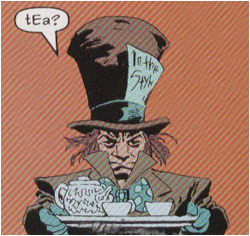
Publisher: DC Comics
First Comic Appearance: Batman #49 (1948)
The Comic Character: The Mad Hatter is a paranoid schizophrenic obsessed with hats of all sizes. He’s also a genius fond of quoting from Lewis Carroll. He’s a criminal mastermind and a nemesis of Batman. While he has no superpowers, the Mad Hatter is a technologist and scientist who specializes in mind control.
Literary Inspiration: The Hatter from Lewis Carroll’s “Alice’s Adventures in Wonderland” (commonly called the Mad Hatter. However, he is never referred by this name in Carroll’s Alice books. He appears with the March Hare at a tea party – which never ends. In “Alice’s Adventures in Wonderland,” the Hatter asks the riddle “Why is a raven like a writing desk?” The Hatter doesn’t have an answer and the riddle remains just that: a riddle.
Literary Origin: “Alice’s Adventures in Wonderland” for published in 1865.
 Valkyrie
ValkyriePublisher: Marvel Comics
First Comic Appearance: Avengers vol. 1 #83 (1970)
The Comic Character: The Valkyrie is a member of the Defenders. She has superhuman strength, slowed aging, hundreds of years of combat experience (especially with a sword) and the ability to speak with the spirits of the dead. She can also see death coming when a person begins to glow.
Literary Inspiration: The Valkyries in Norse mythology are winged female deities who carry off the spirits of slain warriors off the battlefield to Valhalla, the Norse underworld.
Literary Origin: Norse and Germanic mythology. First appearance is the poem Voluspa.
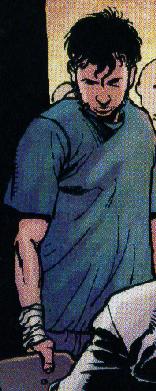 Fagin
FaginPublisher: Marvel Comics
First Comic Appearance: The Brotherhood #1 (2001)
The Comic Character: Fagin is a human mutant with the ability to transform into a purple humanoid with spikes and enhanced strength. He resides (surprise!) in London and lists his occupation as terrorist. He recruits another young mutant to join the terrorist organization The Brotherhood by sweet talking him.
Literary Inspiration: Charles Dickens villain Fagin – a “receiver of stolen goods” and a “merry old gentleman” who is described as disgusting to look at. He is the leader of a group of children he recruited to pick pockets and steal goods. He sweet talks the children while he collects their stolen goods and hordes the profits for himself.
Literary Origin: “Oliver Twist” (1838)
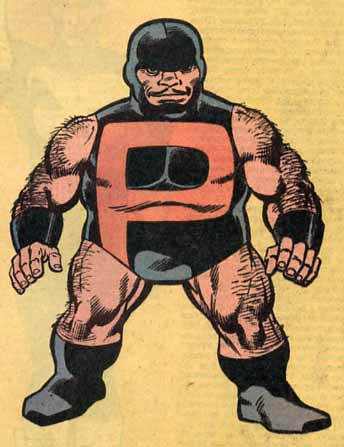 Puck
PuckPublisher: Marvel Comics
First Comic Appearance: Alpha Flight #1 (1983)
The Comic Character: A dwarf with super strength, stamina, and speed. He was a member of the superhero team Alpha Flight. He was born Eugene Milton Judd in Canada and was a soldier, bouncer and secret agent before joining Alpha Flight. Marvel later created a second “Puck” who was the daughter of Eugene, but the comic did poorly.
Literary Inspiration: Puck is a fairy – really a mischievous faun – who also goes by the name of Robin Goodfellow. Puck is Oberon’s (the fairy king’s) servant and causes all kinds of problems when he gives a love potion to the wrong people.
Literary Origin: “A Midsummer Night’s Dream” by William Shakespeare
Morlocks

Publisher: Marvel Comics
First Comic Appearance: Uncanny X-Men #169 (1983)
The Comic Characters: The Morlocks are a group of mutants. They are considered “extreme” mutants that are unable to pass as humans due to their appearance. They lived in a series of underground tunnels beneath New York City. The members include mutants like Skid, who can create a force field around her; Feral, a cat-like human with fangs and claws; and the deformed Caliban, who can sense and track other mutants.
Literary Inspiration: A species of humanoid creatures from A.D. 802,701 who live underground and are described as resembling ants (although they have fur). They hunt in groups at night because they are extremely sensitive to daylight. They feed on a human like species known as Eloi (whom they reference to as “cattle”).
Literary Origin: “The Time Machine” by H.G. Wells (1895)
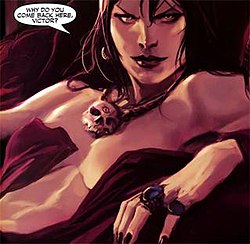 Morgane le Fay
Morgane le FayPublisher: DC Comics
First Comic Appearance: The Demon (Vol. 1) #1 (1983)
The Comic Character: She is a sorceress skilled in black magic. She has the ability to travel to other dimensions. She was an enemy of Wonder Woman. In order to keep being immortal, she needs to steal the life force from other living beings. She wears golden armor to hide her withered and aging body.
Literary Inspiration: Morgan Le Fay was a powerful sorceress and the enemy of King Arthur in medieval England. She is also King Arthur’s half-sister. Originally, she may have been a fairy before being portrayed as a human woman.
Literary Origin: She appears in Arthurian legends in Welsh mythology.
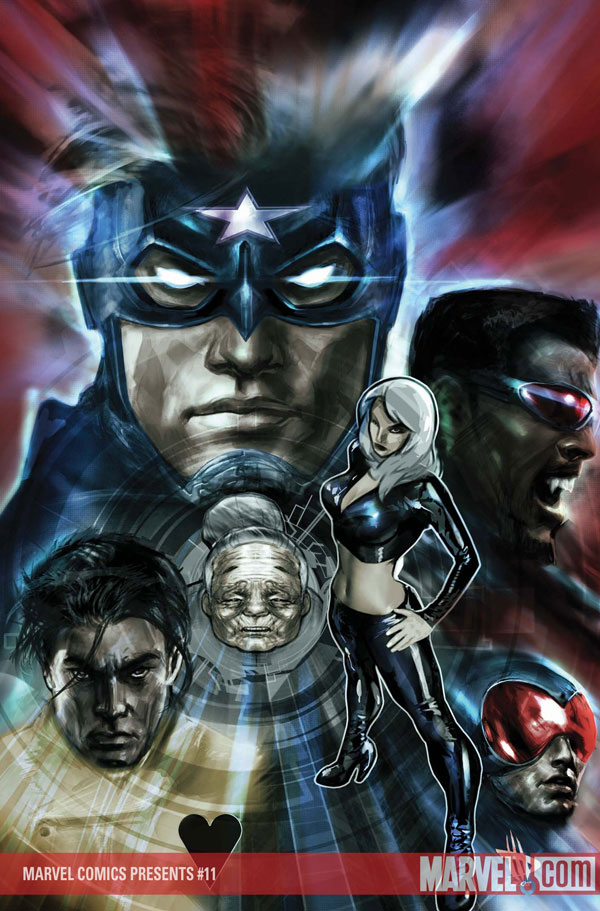 Horsemen of the Apocalypse
Horsemen of the ApocalypsePublisher: Marvel Comics
First Comic Appearance: X-Factor #15 (1987)
The Comic Characters: A team of super villains called Death, Famine, Pestilence, and War. Many different mutants and superheroes have filled the various roles of the Apoclaypse including the Hulk (War), Gambit (Death), Polaris (Pestilence), and Sunfire (Famine).
Literary Inspiration: The four horsemen of the apocalypse appear in the Book of Revelations. Only Death is given a name, but the other three are described and known as Strife, War, and Famine. Strife rides a white horse and carries a bow. War rides a red horse and holds a sword. Famine rides a black horse and carries a weight balance. Death rides a pale green horse and is followed by Hades (or Pluto).
Literary Origin: The Bible
 Solomon Grundy
Solomon GrundyPublisher: DC Comics
First Comic Appearance: All-American Comics #61 (1944)
The Comic Character: A monstrous, simple-minded zombie made up up of swamp matter who is an enemy of Green Lantern and Batman. He has super strength and endurance and can return from the dead.
Literary Inspiration: A nursery rhyme character that was a riddle. Solomon Grundy lives his entire life in a week. The poem starts: “Solomon Grundy/ Born on a Monday” and ends with “Buried on Sunday/ That was the end of/ Solomon Grundy.” The name Solomon Grundy is supposedly from the English food Salmagundi (a salad made from cooked meats, seafood, fruit, and nuts).
Literary Origin: A 19th century nursery rhyme that was made mainstream by James Orchard Halliwell-Phillipps in 1842.
Labels: comics, literature, superheroes
 StumbleUpon |
StumbleUpon |
 del.icio.us |
del.icio.us |
 Technorati |
Technorati |

This work is licensed under a Creative Commons Attribution-No Derivative Works 3.0 License.
The Template is generated via PsycHo and is Licensed.




